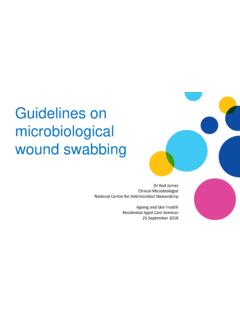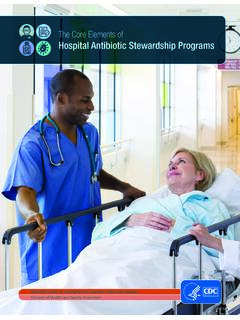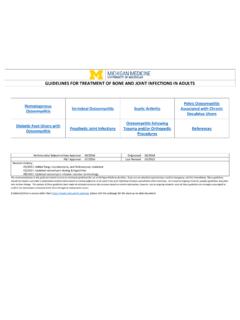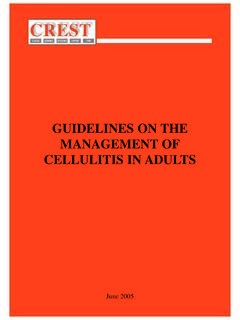Transcription of Management of infection guidelines for primary and ...
1 Management of infection guidelines for primary and community services Aims of these guidelines To encourage the rational and cost-effective use of antibiotics. To minimise the emergence of bacterial resistance in the community. To minimise infections caused by MRSA, C. difficile, resistant UTI and support the ambition of reducing inappropriate prescribing in primary care by avoiding use of quinolones, cephalosporins, co-amoxiclav. To provide a simple, best guess approach to the treatment of common infections. Adapted following NICE- PHE antimicrobial prescribing guidance - managing common infections, along with recommendations and practical advices from Royal Cornwall Hospital Trust. May 2020. Contents Roundworm .. 15. Upper respiratory tract infections .. 5 Threadworm .. 15. Otitis media (child doses).
2 5 Genital tract infections .. 15. Acute diffuse Otitis 5 Acute epididymo-orchitis .. 16. Influenza treatment .. 6 Bacterial 16. Pharyngitis / sore throat / tonsillitis .. 6 Candidiasis .. 16. Sinusitis acute or chronic .. 6 Chlamydia trachomatis .. 16. Lower respiratory tract infections .. 7 Pelvic Inflammatory 17. Acute bronchitis and acute 7 Chronic genital herpes simplex .. 17. Acute exacerbation of COPD .. 7 primary genital herpes simplex .. 17. Bronchiectasis 8 Postnatal infections .. 17. Community-acquired pneumonia .. 8 Trichomoniasis .. 18. Severe CAP in a community hospital setting .. 9 Skin / soft tissue infections .. 18. Hospital acquired pneumonia in a community hospital setting .. 9 Animal / human bites .. 18. Aspiration pneumonia in a community hospital 9 Insect bites and stings .. 18.
3 COVID-19 pneumonia in adults in the community .. 10 Cellulitis .. 18. Meningitis .. 10 Cellulitis (managed in hospital) .. 19. Suspected meningococcal disease .. 10 Dermatophyte infection of nails .. 19. Prevention of secondary cases of meningitis .. 10 Dermatophyte infection of the skin .. 19. Urinary tract infections .. 10 Impetigo .. 20. Uncomplicated UTI no fever or flank pain .. 10 Infective lactation mastitis .. 20. Acute 12 Leg ulcers .. 21. Acute pyelonephritis .. 12 Diabetic foot ulcer .. 21. Catheter associated bacteriuria .. 12 MRSA .. 21. Lower UTI in patients with an indwelling catheter .. 12 MRSA colonisation .. 22. Prophylaxis for recurrent UTI in 13 Panton-Valentine Leukocidin (PVL) staphylococcal infection .. 22. Staph aureus in urine .. 13 Varicella and Herpes zoster .. 22. UTI in pregnancy.
4 13 Eye infections .. 22. Gastro-intestinal tract infections .. 14 Acute infective conjunctivitis .. 22. Acute Cholecystitis .. 14 Dental infections .. 23. Clostridium difficile .. 14 Acute-dento-alveolar infection .. 23. Diverticulitis .. 14 Acute necrotising ulcerative 23. Eradication of Helicobacter pylori .. 14 Acute pericoronitis .. 23. Gastroenteritis .. 15 Useful resources .. 24. Giardiasis .. 15. Management of infection guidelines for primary and community services | Page 2. Principles of treatment This guidance is based on the best available evidence but its application must be modified by professional judgement and any knowledge of previous culture results flucloxacillin is very rarely a good choice in patients colonised with MRSA. A dose and duration of treatment is suggested, but may need modification for age, weight, renal function or if immunocompromised.
5 In severe or recurrent cases consider a larger dose or longer course. Use simple, generic antibiotics if possible. Avoid broad spectrum antibiotics ( co-amoxiclav, quinolones and cephalosporins) when narrow spectrum antibiotics remain effective, as broad spectrum antibiotics increase the risk of side effects, clostridium difficile infection , MRSA and future resistant infections in exposed patients). Prescribe an antibiotic only when there is likely to be a clear clinical benefit. This guidance should not be used in isolation; it should be supported with patient information about safety netting, back-up antibiotics, self-care, infection severity and usual duration, clinical staff education and audits. Materials are available on the RCGP TARGET website and NICE guidance visual summaries. Do not prescribe an antibiotic for viral sore throat, simple coughs and colds.
6 Limit prescribing over the telephone to exceptional cases. Consider for empiric treatment: Does the patient have a bacterial infection ? Is an antibiotic treatment necessary? Have relevant specimens been collected? Is the patient allergic to any antibiotics? In severe infections, immunocompromised or high-risk of complications, give immediate antibiotic and always consider possibility of sepsis. Do not use penicillin, amoxicillin, co-amoxiclav, flucloxacillin, pivmecillinam or piperacillin/tazobactam in patients who are allergic to penicillin. Please assess nature of allergy status to distinguish intolerance from true allergy. Previous anaphylaxis following penicillin: do not use any of the above or cephalosporins. Hypersensitivity to penicillin i. True allergic reactions to penicillins occur in 1% of exposed individuals but reported in 10% of patients; anaphylactic reactions occur in fewer than of treated patients.
7 If nature of the reported allergic reaction is unknown, avoid the use of the antibiotic concerned if there is a reasonable alternative. ii. Self-reported penicillin allergy is relatively common. It is important therefore to clarify the reaction the patient experienced (endorse reaction in detail in drug allergy or sensitivities section of patients electronic record). In some cases it is simply a common side effect of the drug ( diarrhoea or vomiting) rather than true allergic reaction ( rash, angiodema or anaphylaxis). Patients with true allergy to the beta-lactam ring in penicillin molecules will react to all penicillins Penicillin V, Amoxicillin, Flucloxacillin and Co-Amoxiclav. If they react to one of the penicillin molecule side chains then they may also have a crossover-allergy to other - Lactams ( cephalosporins) that share similar side chains.
8 The risk of crossover is quoted as between 1% and 10% for cephalosporins ( cefalexin) with the risk dependant of side chain similarities. If the patient reports a mild reaction to penicillins ( rash alone, with no symptoms of anaphylaxis) cephalosporins may still be used - patients should be made aware of the signs and symptoms of an allergic reaction and seek immediate medical advice. Patients with serious allergic symptoms to penicillins ( anaphylaxis, breathing difficulties, facial swelling or major skin reactions) should avoid cephalosporins and alternative agents be administered. For further advice on antibiotic choice please contact a consultant microbiologist. Management of infection guidelines for primary and community services | Page 3. Do not use tetracycline or doxycycline in children under 12 years, pregnant women or patients with a history of tetracycline allergy.
9 Doxycyline can be given with food/dairy products but not with antacids. In pregnancy, where possible, avoid tetracycline, aminoglycosides, quinolones, azithromycin, clarithromycin and high dose of metronidazole (2g stat), unless the benefits outweigh the risk. Amoxicillin, Erythromycin and cephalosporin are safe in pregnancy. Short- term use of nitrofurantoin is not expected to cause foetal problems (theoretical risk of neonatal haemolysis). Trimethoprim is also unlikely to cause problems unless poor dietary folate intake, or taking another folate antagonist. Current recommendations are that no additional contraceptive precautions are required when non-liver enzyme inducing antibiotics are combined with oral contraceptives, contraceptive patches or vaginal rings unless diarrhoea or vomiting occurs. Anecdotal reports of contraceptive failure have been made with the concomitant use of antifungals.
10 Experience in anticoagulant clinics suggests that the INR can be altered by a course of antibiotics or antifungals. Increased frequency of INR monitoring is necessary during and after a course of antibiotics until the INR has stabilized. Cephalosporins, macrolides, tetracyclines, quinolones, metronidazole and trimethoprim seem to cause a particular problem. Contact the anticoagulant clinic for any further advice. Avoid use of quinolones unless benefits outweighs risks as evidence indicates that they may be rarely associated with long lasting disabling neuro muscular and skeletal side effects (drug safety update March 2019). MHRA has also issued a drug safety update in November 2018, which reported a two-fold increase in risk of aortic aneurism and dissection with older people being at higher risk. Once microbiology results are available: treat according to culture results and sensitivity.






